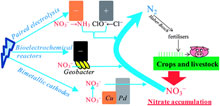Publication
718
Dalton Trans. , 5, 9726-9742, 2012
DOI:10.1039/c2ee23062c
|
|
|
|
|
 |
Powering denitrification: the perspectives of electrocatalytic nitrate reductions |
|
|
|
|
Matteo Duca† and Mark T.M. Coper
Leiden Institute of Chemistry, Leiden University, PO Box 9502, 2300 RA, Leiden, The Netherlands
† Present adress : Laboratoire d’Electrochimie Moléculaire, Unité Mixte de Recherche Université−CNRS No. 7591, Université Paris Diderot, Sorbonne Paris Cité, Bâtiment Lavoisier, 15 rue Jean de Baïf, 75205 Paris Cedex 13, France
Imbalances in the nitrogen cycle caused by human activities (combustion, fertiliser-intensive agriculture) have resulted in alarmingly increased levels of nitrate in groundwater and other water bodies, with potentially health-threatening consequences. The electrocatalytic removal of nitrate from polluted water is a promising alternative to bacterial denitrification, provided that full selectivity to harmless N2, which can be returned to the atmosphere, is achieved. This perspective article discusses the state-of-the-art of research on electrocatalytic denitrification, critically evaluating the obstacles still hampering large-scale application of this technique. The milestones of fundamental research focussing on the cathode reaction will first be dealt with, followed by their translation into electrochemical reactors of practical interest. Finally, a short foray into the novel field of bioelectrochemical reactors will close the article. Challenges and opportunities pertaining to these three topics will be analysed. |

